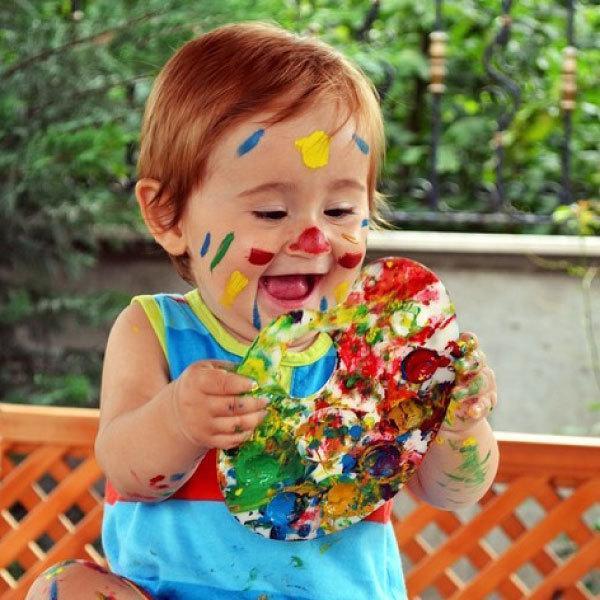Feeling blue! Seeing red! Green with envy or yellow with fear…. These colourful phrases reflect how we feel. Colour is a very real thing in our lives and influences what we do and how we feel. For impressionable little minds, learning colours for kids is even more relevant! Colours certainly catch the attention of little ones more easily, but they do a lot beyond that. They contribute to the growth, development, receptiveness, moods and more of children. This blog is all about colour psychology, the importance of colours in life and fun activities for kids learning colours.
Colour Psychology
Colour Psychology is an ancient idea and has a place in all ancient cultures. People would surround themselves with different colours that soothed them, made them sleep better or feel better. In fact, they had given much importance to colour in life with colours being associated with ceremonies and traditions.
While Holi colours are fun (and you can read about safe colours on our blog too) they are not permanent. They come around once a year. How do we keep colours in our lives all year round? Especially when they can influence us, make us feel better, help us focus and elicit the desired behaviour.
Ways Learning Colours Can Help Kids
Colours are gender-neutral, and you can use them in your child’s room and play area for more than just making it pretty. Colour psychology suggests that calming colours like blue and green are great for quiet rest areas, especially for kids who might have sleep issues or are prone to tantrums.
1. Helps In Sound Sleep
The importance of colour in life is beyond aesthetics. If you want your children to sleep well, try using cool colours like blue, green, or purple. Their calming effect can make your child’s room feel spacious and relaxing, like the blue sky or the ocean.
2. Enhance Growth & Development
Avoid a profusion of dark colours in your child’s room as they can inspire gloomy, stormy day feelings. Bright, warm colours are great in the playroom since are known to enhance growth and development.
3. Increases Attention & Focus
Yellow during study time to enhance attention and focus is an excellent choice. A yellow tablecloth or placemat at the homework station may help too as will small items like a yellow folder, pencils, or pencil case. If you have a small room dedicated to studying, definitely paint it yellow!
Also Read: How To Solve Floor Puzzles Quickly
4. Stimulates Appetite
Notice how bright, colourful food is eaten faster? Bright red, yellow, or orange dishes and placemats are great in the kitchen, as these colours stimulate appetite. Use this colour psychology to make your kids enjoy their meals.
5. Is A Great DIY Activity
In big cities, we all do not have the luxury of having several dedicated spaces for children alone. In such cases, it’s easy just to splash colour temporarily wherever the activity is. A colourful mat with warm colours while playing will have as much effect on the child’s growth and development as a painted wall. This will also encourage them to learn colours.
You can also use curtains and sheets to add the desired colours to your child’s room. The advantage of these easy-to-do ideas is that they can change and grow along with the child.
Small do-it-yourself projects where you paint just small squares or geometric shapes on a wall or a wardrobe to enhance the look and feel of space or use stamps to create a pattern are fun and engaging teaching colour activities that can also include colour therapy.
6. Improves Visual Attention
It is found that learning colours for toddlers improves visual attention. Full colour holds more attention than black and white (Schaie & Heiss, 1964), and warm colours like red generate more arousal and attention than cool colours like blue (Birren, 1978). Use colourful toys and learning materials for kids.
Also Read: How to Reduce Screen Time For Kids
7. Language Development
When you describe an object with associated colour, it helps kids understand them better. A “red apple” and “blue sky’ make learning colours for kids more meaningful and improve their language skills.
8. Foster Creativity
Cool colours like blue have been proven to improve creativity in children based on research on the psychological effect of colours on children’s creativity (Ananya Jain, 2020). Teaching colour activities like painting and colouring will boost creativity.
9. Fine Motor Skills
Colouring is a fine motor skill-improving activity. Finger painting, painting with a brush or sponge or simply hands-on playing with colours are not just activities for kids learning colours, they also boost fine motor skills.
10. Improves Hand-Eye Coordination
Teaching colours to preschoolers through colouring and painting can improve their hand-eye coordination. You will often find children completely immersed in their colouring book carefully filling in the pictures. This improves their focus and hand-eye coordination.
Colours inspire creativity and words can motivate. If you are looking for extra encouragement, check out our inspirational quotes for kids to inspire them.
Let Your Kid Paint Playfully With Shumee’s Colouring Art & Craft Activities For Kids
Here are Shumee’s selected arts and crafts activities that teach colours, uses of colours and colour psychology to kids.
-
Paint Your Own Wooden Unicorn Set With 30+ Cute Stickers
The paint-your-own wooden unicorn set is a fun way to learn colours for kids. The kit comes with 6 organic colours, a wooden paint brush and 30+ fun stickers to decorate the wooden unicorn.
-
Paint Your Own Dessert-Themed Magnetic Art Kit
The paint-your-own dessert-themed magnetic art kit is not just a medium of creative expression. It also lets children proudly display their creations. With non-toxic paint and brush and 6 dessert-themed wooden magnets, this DIY teaching colour activity is a great way to learn colours. This is also an ideal kids return gift for birthday parties.
-
Finger Painting Activity Book, Art & Craft Kit
Finger painting encourages children to explore colours, textures and shapes with their hands. Shumee’s finger painting book kit is an easy method of teaching colours. The activity book lets children get creative and play anywhere. Save it as a memento of your little one’s artistic expression.
-
Carnival Fun Coloring Book and Organic Crayon Kit
Colouring books are the best homeschool toys. Teach colours to preschoolers with the carnival fun colouring book kit from Shumee. Along with learning colours, they will also learn about animal names and habitats. The vibrant and non-toxic crayons that come with this kit are perfect for little hands for colour education.
-
Non-Toxic Finger Paints
The 6-bottle pack of non-toxic finger paint is a great way to learn colours for toddlers. Kids can explore colours, textures and shapes using their hands making this finger painting kit also a sensory toy for kids. Safe and easily washable, this teaching colour activity will be loved by your little one.
Conclusion
Colours lift us up and influence us every day. Colours are also the most inexpensive way to make a difference. Go ahead and paint the room in colours that help your child’s growth and development to the maximum. You don’t need to make drastic changes, just making small ones will also help. The only thing you must keep in mind is that the child will grow up and the needs might change with each stage. Wooden toys for kids from Shumee like the paint-your-own series are great tools for children to learn colours. Incorporate colour education in their playtime and let them know the importance of colour in life.
Look at the colours around you this Holi and after you have enjoyed those lovely colours safely, find ways to incorporate them in your everyday life. Share with us how it works for you and your child.
Happy Holi!
Frequently Asked Questions
What colours are best for baby development?
Bright colours like red, yellow and blue boost brain development and sensory skills. Soft pastel colours are found to have a calming effect. Colour education through toys, books and activities is necessary for kids to understand the importance of colours in life.
When do babies see colours?
Babies start seeing colours when they are around 4 months old. Before that they see only black, white and grey. Colourful toys and teaching colour activities is good for visual growth.
Is colour good for child development?
Yes. Colours play an important role in child development. It can influence mood, learning and creativity of the child. Activities for kids learning colours can improve creativity and attention.
What colours makes babies happy?
Babies start recognising primary colours like red and blue by 4 months. Colour psychology of babies is that bright colours catch their attention faster.
How to teach colors?
Teach colours to toddlers using fun and interactive activities. Colouring books, finger painting and paint your own toys are excellent for learning colours for toddlers. If you are looking for a unique gift for 5-year-old boys, these painting kits make a good choice.
Parent's Favourites At Shumee
Wooden Toys | Toys For 2 Year Boy | Montessori Toys | Wooden Kitchen Set For Kids | Puzzles For Kids | Baby Products | Toys For 4 year Old | Story Books For Kids

